- Acne
- Actinic Keratosis
- Aesthetics
- Alopecia
- Atopic Dermatitis
- Buy-and-Bill
- COVID-19
- Case-Based Roundtable
- Chronic Hand Eczema
- Chronic Spontaneous Urticaria
- Drug Watch
- Eczema
- General Dermatology
- Hidradenitis Suppurativa
- Melasma
- NP and PA
- Pediatric Dermatology
- Pigmentary Disorders
- Practice Management
- Precision Medicine and Biologics
- Prurigo Nodularis
- Psoriasis
- Psoriatic Arthritis
- Rare Disease
- Rosacea
- Skin Cancer
- Vitiligo
- Wound Care
Article
Developing a 'vaccine' for melanoma
The "vaccine" approach of customizing the intervention to the patient is antithetical to the blockbuster mentality of much of the pharmaceutical industry.
Pittsburgh - One of the hottest areas of cancer research today is "vaccines," or immunotherapy, to stimulate and direct the body's own anti-cancer activity.
Most of the research uses dendritic cells, a principle antigen-presenting cell of the immune system, exposed to a cocktail of various combinations of antigens and cytokines to guide the immune response in taking on tumors.
"Tumors are so slow growing that they are usually perceived as 'self' by the immune response and there is no reason to attack them. They also have multiple mechanisms which dampen the immune response against them," Louis D. Falo Jr., M.D., a researcher and chairman of the department of dermatology at the University of Pittsburgh School of Medicine, explains.
He says this approach overcomes many of the tolerogenic and suppressive mechanisms the tumor has evolved for protection.
It has shown promise in human trials but the number of variable factors makes it difficult to answer some questions of very basic science of what is happening and how, so as to better tailor the process.
Series of experiments

Dr. Falo performed a series of experiments using bone marrow-derived murine dendritic cells, manipulated ex vivo to resemble those being used in clinical trials, and injected them into mice bearing aggressive ±6 melanoma tumors. It drove a Th1 response, which, by itself, was sufficient to stop tumor growth.
But more importantly, the study showed that it was the CD4+ T-cells and macrophages, rather than the CD8+ T-cells, that were doing the heavy lifting.
"The Th1 response on its own was effective in killing tumor cells.
"That's important because most of the clinical trials right now monitor patients' CD8 responses, but this work demonstrates that we also need to monitor their CD4 responses," he says. "It suggests that we have to build that type of monitoring into future vaccine trials to better understand how they work, and to determine how effective they really are."
The study was presented in detail in the Nov. 1, 2005, issue of Cancer Research.
For Dr. Falo, one of the greatest values of this "reverse translation" study is that it "demonstrates how important it is to have basic research, translational research and clinical trials all intimately tied together to move projects forward more quickly and efficiently."
This kind of dialectic, a back-and-forth between work in humans and in the mouse model with each informing the other, is crucial to immunotherapy and developing more effective second- and third-generation vaccines for human trials.
"The mouse model is extremely important because we can manipulate it and control all of the variables," Dr. Falo says. "One of the biggest hurdles to advancing human immunotherapies is the individual variability that we see from patient to patient. All of that variability disappears if you can specifically control the variables, as you can in the mouse model.
Newsletter
Like what you’re reading? Subscribe to Dermatology Times for weekly updates on therapies, innovations, and real-world practice tips.















